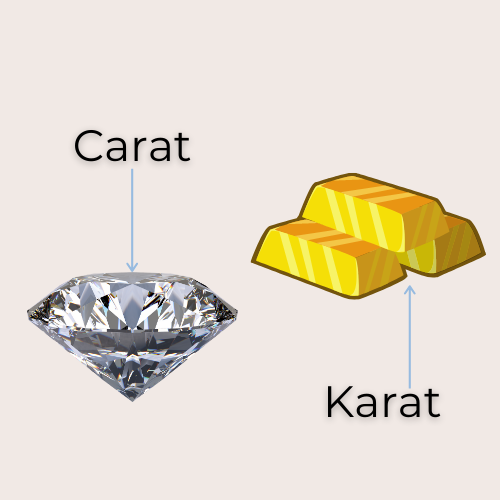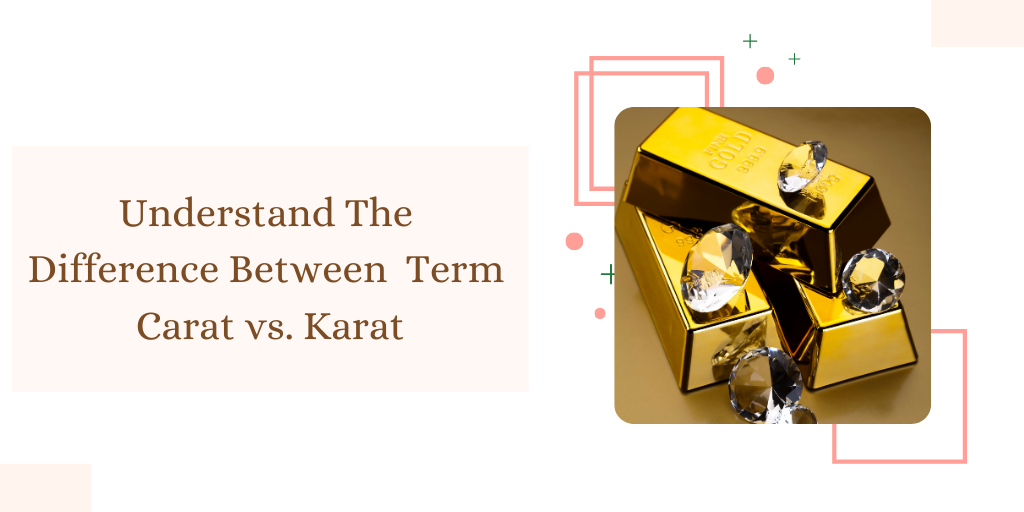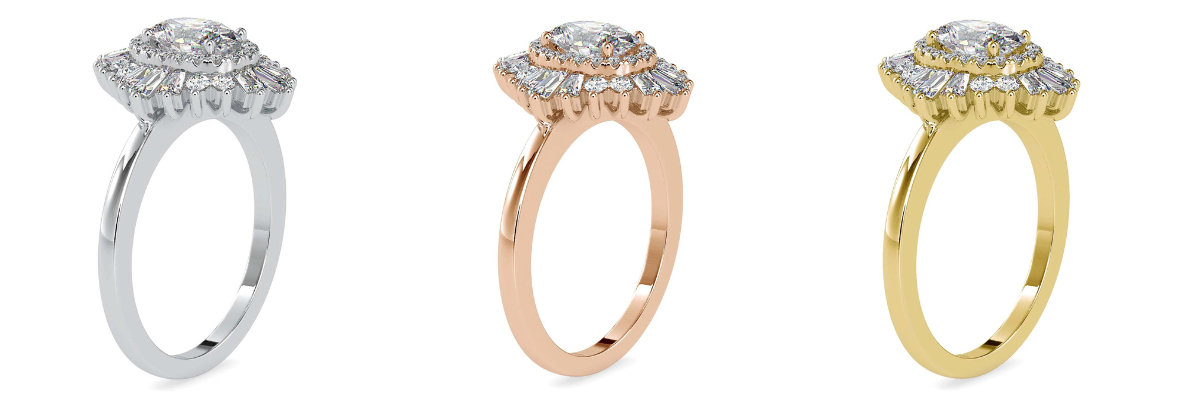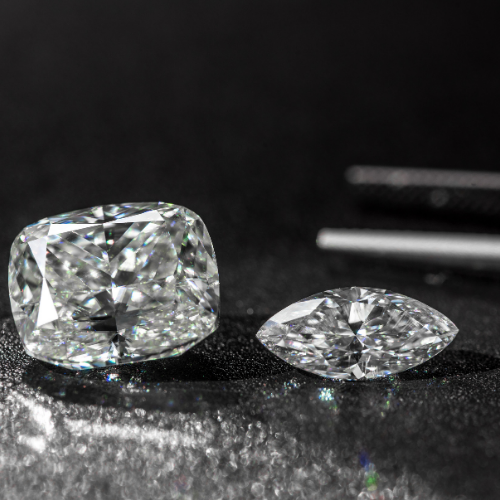
Once a potential customer has begun the search for the perfect engagement ring, they will come across various new pieces of vocabulary that would specifically serve the purpose of describing different aspects of the material used in the making of jewelry items. Two such words would be the terms carat vs karat, which most often lead to a lot of confusion amongst customers due to the similarities between how the words appear.
Although they sound the same, there is a huge difference between carat and karat to the limit wherein the only major similarity between the words is their identical pronunciation. This difference is part of the vital knowledge that every jewelry customer must have when shopping for precious stones and metals. 
A carat, shortened into ‘ct’, can be defined as the physical weight of a diamond or a precious stone which is a globally recognized standard whereas karat is a mode of measurement designed to quantify the purity of gold found in an item of jewelry. A detailed explanation of both these definitions is given below.
What is a Carat?
Often assumed to represent a precious stone’s size, carat weight is a technical measurement of a diamond’s actual weight and it is an acknowledged aspect of a gemstone’s identity wherein customers often rely on it while deciding the budget they seem would be appropriate to spend on the diamond or other gemstones.
In terms of measurement, one carat can be equated to 200 milligrams or 0.2 grams. Digitally, 1 carat is expressed as 1.00 carat which helps in jewellers in allotting accurate and exact carat weight to the stones. If the other aspects of a diamond such as the cut, clarity, and colour are all made to be equal, then the price of the diamond would be directly proportional to its carat weight.
The effect of carat weight on the other aspects of a diamond is quite significant and hence important to talk about.
Also Read: Diamond Carat: Understanding Sizing And Measurement Guide
Diamond Sizes
Although a diamond’s size and carat weight are not synonymous as many people incorrectly presume, they still walk hand in hand and indirect proportionality. A 5.1 mm sized diamond will amount to 0.50 ct and 1.00 ct stone would be around 6.5 mm. Hence, this shows that as a diamond shows an increase in carat weight, it may increase in size too.
Diamond Shapes
Carat weight when examined from the perspective of a diamond’s shape can often be misleading or misunderstood since diamonds of equal carat weight can still express a sizable difference due to their shapes.
Generally, carat weight is an undermined factor in fancy shapes like oval, emerald, marquise, and pear diamonds which appear larger than their weights in carat. This is mainly because of the extended silhouettes and large top surface which gives the illusion that the stone is bulky even though its carat weight might say otherwise.
The one shape in diamonds where the carat weight and size are true to each other is the round diamonds. However, if we begin comparing a 1-carat pear shaped diamond with a carat round diamond, then the pear will almost most definitely appear a lot larger.
Therefore, fancy shaped diamonds are the best options for those who wish to incorporate a larger looking diamond jewelry in their collection while also ensuring that they save on the diamond and their pockets which could both be compromised if a larger carat weighted diamond in a simple shape is purchased.
Price
Carat weight is definitely a crucial factor in the pricing of jewelry studded with a diamond or other precious stones although other aspects such as the cut, clarity, and color are also important. These four factors generally make up the 4 C’s of a diamond.
When it comes to purchasing a diamond, the price range can be quite broad, spanning from approximately $500 to as high as $10,000 or more, depending on these various factors.
These prices, however, show a fall when customers decide on buying jewelry made of lab grown diamonds since these diamonds even though show a 100% similarity in optical and physical properties with naturally-mined diamonds cost a lot less than the latter with a difference as high as 20-40%.
What is a Karat?
Karat, a term exclusive for gold, is a form of measurement that aids in determining the purity of gold found in any item of gold jewelry like gold rings, necklaces, etc. Karat measures the proportion of pure gold within an alloy.
Fundamentally, karat talks about the amount of pure gold present in a piece of gold jewelry which means that higher the karat rating a jewelry piece has, the higher the quantity of pure gold present in it.
Three basic karat ratings are found which are 14K, 18K, and 24K; out of which 14K is denoted to gold jewelry with the lowest amount of pure gold and 24K refers to pieces of gold jewelry made with 100% pure gold.
Factors Affecting the Value of a Carat vs Karat
When purchasing jewelry, you should pay close attention to both carat and karat.
The value of a diamond carat can vary based on factors such as color, clarity, and cut. A small, flawlessly clear diamond may be more valuable than a larger one with visible imperfections. Therefore, it’s essential to consider these additional factors when purchasing diamond jewelry.
Karat be available in different colors such as white gold, yellow gold and rose gold. The value of a karat can vary based on factors such as pure gold, and color.

White gold is very similar to platinum in appearance since both these precious metals showcase a silvery shade of color. It is also highly compatible with various gemstones and is generally purchased by customers who want to experience the style and effect of platinum but do not wish to invest too much since platinum has always cost 30% higher than gold.
Yellow gold is generally made with a mixture of copper, gold, and nickel which results in the alloy expressing a warm yellow tint in its appearance and closely resembling pure gold.
Rose gold is a fairly new addition to the trend with its gorgeous soft pink color and neutral warmth in shade. Perceived as a romantic meal, it is a popular choice in engagement rings and complements various precious gemstones very well.
14 Karat
A popular precious metal choice for brides and grooms, 14 karat gold is best suited for engagement rings and wedding bands, hence, making them a much-preferred choice by couples.
Gold jewelry made of 14 karat gold is more durable and affordable when compared to their successors of 18 and 24 karat gold. With 58.3% pure gold, this durability is a result of the mixture of other metals found in such jewelry, leading to increased resistance to scratches and dents.
Although the amount of pure gold present in jewelry made of 14 karat gold decreases, this allows the jewelry to be more durable.
18 Karat
Another popular choice for customers, the 18 karat gold is famous for its own set of reasons, mainly since it has more pure gold present in its jewelry. With about 75% of pure gold making up an 18 karat gold jewelry composition, these result in appearing a lot more vibrant and rich in colour.
It is also more suitable for customers with sensitive skin which could get triggered due to foreign metals and so for people with such skin, an 18 karat gold jewelry is a good choice since it is less likely to cause any allergies or side effects.
However, the higher quantity of metal also leads to decreased durability and higher prices which could be heightened by a few hundred dollars when compared to jewellery made of 14 karat gold. One such example could be a solitaire ring which would cost $790.00 in 14k gold but will amount to $890.00 if bought in 18k gold.
24 Karat
The purest gold of them all, a 24 karat gold has no mixture present in its composition and a pure, non-alloyed form. It is also the rarest option out of the three and appears richly yellow, giving off a charmingly beautiful look which is mainly because of the high quantity of pure gold present in jewelry made of 24 karat gold. The only option available in 24 karat is yellow gold since a 24 karat white or rose gold cannot be found.
Although this is a stunning form of precious metal, customers are often advised against purchasing or making engagement rings or wedding bands out of 24 karat gold since it is very soft and highly susceptible to scratches and dents. 24 karat gold is also a lot more expensive than their other two counterparts.
Jewelry made of 24 karat gold is generally purchased as an investment since the value of such jewellery tends to always remain very high.
Where to Buy the Best Diamond and Jewelry?
If you’re looking to purchase diamond jewelry with the best carat vs karat quality, you’re purchasing from a trusted source.
When buying diamond jewelry, it’s essential to understand the difference between carat and karat to make an informed choice. You can get your hands on natural diamonds and jewelry at the best price at RRP Diamonds.
Conclusion
In summary, carat and karat are terms that play pivotal roles in the world of gemstones and jewelry. Carat measures the weight of gemstones, while karat indicates the purity of gold. By distinguishing between the two and considering the additional factors that affect value, you can confidently choose the perfect piece of jewelry for any occasion.
If a customer is confused about which type of gold or diamond is best suited for them this article is an excellent guide for the process of judging precious metals and stones based on their carat and karat!
FAQs
How to differentiate between carat and karat?
Carat measures the weight of gemstones, with 1 carat equal to 200 milligrams. Karat measures the purity of gold in jewelry, with 24K being pure gold.
What are the common karat values for gold jewelry?
Common karat values include 10K, 14K, 18K, and 24K, each indicating the percentage of pure gold in the alloy.
What is the significance of carat in the diamond industry?
Carat weight is crucial in evaluating a diamond’s value, with larger diamonds generally being more valuable.

